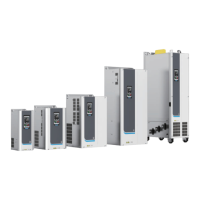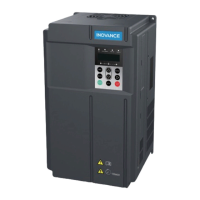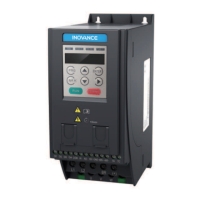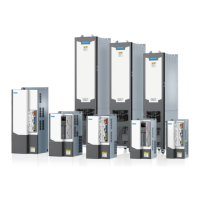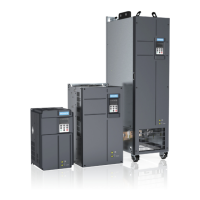Commissioning and Trial Run
‑54‑
Param
eter
Code
Parameter
Name
Value
Range
Default Parameter Code
F2‑05 Switchover
frequency 2
F2‑02 to
F0‑10
10.00 Hz The speed loop PI parameters are divided into low‑speed and
high‑speed groups. If the running frequency is lower than F2‑02
(switching frequency 1), the speed loop PI adjustment parameters
are F2‑00 and F2‑01. If the running frequency is higher than F2‑05
(switching frequency 2), the speed loop PI adjustment parameters
are F2‑03 and F2‑04. If the running frequency falls between
switching frequency 1 and switching frequency 2, speed loop PI
adjustment parameters are switched between F2‑00/F2‑01 and
F2‑03/F2‑04. The parameter value must be larger than F2‑02
(switching frequency 1).
F2‑06 Vector
control slip
gain
50% to
200%
100% In the SVC mode, this parameter is used to adjust the speed
stability accuracy of the motor. For example, when the running
frequency of the motor is lower than the output frequency of the
AC drive, you can increase the value of this parameter. In the FVC
mode, this parameter is used to adjust the output current of the
AC drive with the same load. For example, if the load capacity of a
high‑power AC drive is weak, decrease the value of this parameter
gradually. No adjustment is required under normal
circumstances.
2.2.12(Optional) FVC Parameter Settings
Parame
ter
Code
Parameter Name Value Range Default Parameter Code
F1‑27 Encoder PPR 1–65535 1024 This parameter defines the number of pulses generated per
revolution of the encoder disk. In the feedback vector
control (FVC) mode, set this parameter properly; otherwise,
the motor will malfunction.
F1‑28 Encoder type 0: ABZ
incremental
encoder
1: 23‑bit
encoder
2: Resolver
3: External
input
4: Sin‑cos
encoder
0 Encoders are classified into incremental encoders and
absolute encoders.
● An incremental encoder converts displacement into
periodic electrical signals, which are then converted into
pulses that are counted. That is, the magnitude of
displacement is expressed as the number of pulses.
● An absolute encoder maps each position to a digital code.
Therefore, its indication is related only to the start and
end positions of the measurement, but is not related to
any intermediate process of measurement.
F1‑34 Number of resolver
pole pairs
1–65535 1 A resolver is an electromagnetic transducer, also known as
a synchronous resolver. It is a small AC motor used to
measure angles, including angular displacement and
angular velocity of shafts. It consists of stators and rotors.
This parameter defines the number of pole pairs of a
resolver. More pole pairs indicate higher accuracy.

